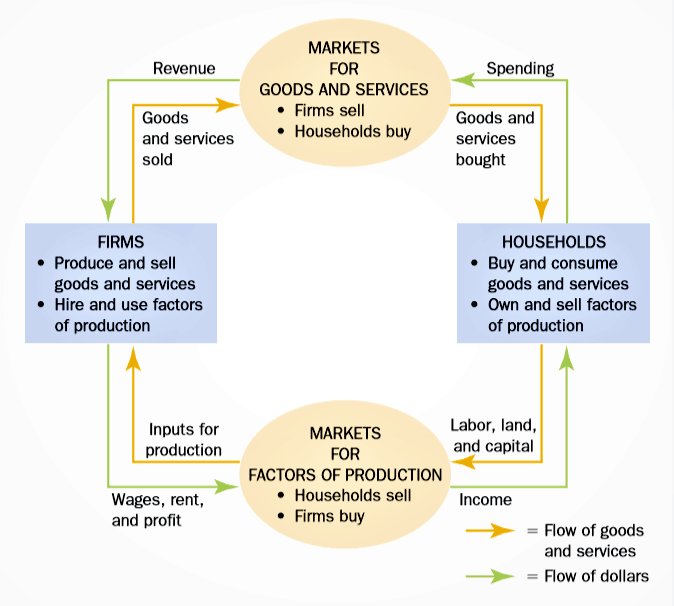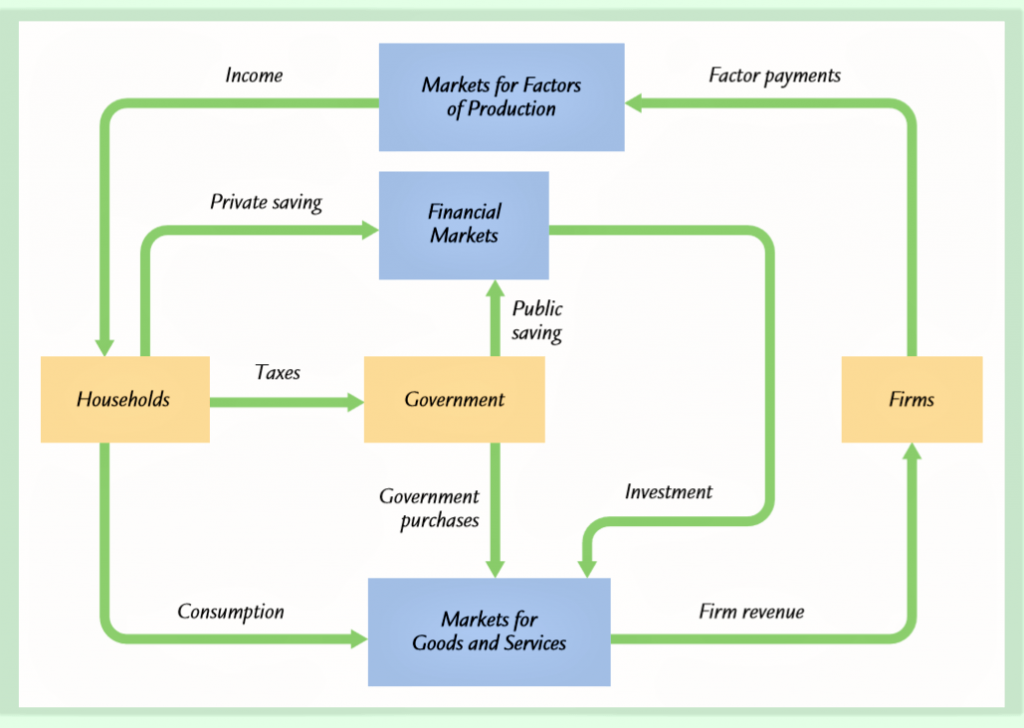Draw a Circular Flow Diagram
Circular catamenia diagram
Circular catamenia Diagram is a visual model of the economy that shows how dollars flows through markets among households and firms.
Breaking downward Round Catamenia Diagram
The economy consists of millions of people engaged in many activities—ownership, selling, working, hiring, manufacturing, then on.
To sympathize how the economy works, we must find some fashion to simplify our thinking nearly all these activities.
In other words,
We demand a model that explains, in general terms, how the economy is organized and how participants in the economy interact with ane another.

Above Diagram presents a visual model of the economy, called a circular menstruation diagram. In this model, the economic system has two types of decisionmakers—households and firms.
Firms produce goods and services using inputs, such as labor, land, and capital (buildings and machines). These inputs are chosen the factors of production.
Households own the factors of production and swallow all the appurtenances and services that the firms produce.
Households and firms interact in ii types of markets.
In the markets for appurtenances and services, households are buyers and firms are sellers. In particular, households buy the output of goods and services that firms produce.
In the markets for the factors of production, households are sellers and firms are buyers. In these markets, households provide firms the inputs that the firms use to produce goods and services.
The circular menstruum diagram offers a elementary manner of organizing all the economic transactions that occur between households and firms in the economic system.
The inner loop of the circular-flow diagram represents the flows of appurtenances and services between households and firms.
The households sell the apply of their labor, land, and capital to the firms in the markets for the factors of production.
The firms then employ these factors to produce goods and services, which in turn are sold to households in the markets for goods and services.
Hence, the factors of production flow from households to firms, and appurtenances and services flow from firms to households.
The outer loop of the circular-flow diagram represents the respective flow of dollars. The households spend money to purchase goods and services from the firms.
The firms use some of the revenue from these sales to pay for the factors of production, such every bit the wages of their workers.
What's left is the profit of the business firm owners, who themselves are members of households.
Hence, spending on goods and services flows from households to firms, and income in the form of wages, rent, and turn a profit flows from firms to households.
Instance of Circular Flow Diagram
Allow's take a tour of the circular flow by following a dollar bill every bit it makes its way from person to person through the economy.
Imagine that the dollar begins at a household, sitting in, say, your wallet.
If you want to buy a loving cup of coffee, yous take the dollar to one of the economy'due south markets for goods and services, such as your local Starbucks coffee shop.

In that location you lot spend it on your favorite potable. When the dollar moves into the Starbucks cash register, information technology becomes acquirement for the firm.
The dollar doesn't stay at Starbucks for long, however, because the firm uses it to buy inputs in the markets for the factors of production.
For instance, Starbucks might use the dollar to pay hire to its landlord for the space it occupies or to pay the wages of its workers. In either instance, the dollar enters the income of some household and, one time again, is dorsum in someone's wallet.
At that bespeak, the story of the economy'south circular flow starts once again.
Realistic Round flow diagram
The epitome below more accurately reflects how real economies function.

It shows the linkages among the economic actors—households, firms, and the government. And how dollars flow amongst them through the various markets in the economy.
Allow'due south await at the flow of dollars from the viewpoints of these economical actors.
Households receive income and utilise information technology to pay taxes to the government to consume appurtenances and services, and to save through the financial markets.
Firms receive revenue from the auction of goods and services and use it to pay for the factors of production.
Both households and firms borrow in financial markets to purchase investment goods, such as houses and factories.
The government receives acquirement from taxes and uses it to pay for government purchases. Any excess of tax revenue over government spending is chosen public saving, which can exist either positive (a budget surplus) or negative (a budget deficit).
Summary
The above circular flow diagram in Figure is i elementary model of the economy. It dispenses with details that, for some purposes, are significant.
A more circuitous and realistic round-flow model would include, for instance, the roles of regime and international merchandise.
Yet these details are not crucial for a basic understanding of how the economic system is organized.
Considering of its simplicity, this round flow diagram is useful to proceed in mind when thinking near how the pieces of the economy fit together.
Source: https://ilearnthis.com/a/circular-flow-diagram/
0 Response to "Draw a Circular Flow Diagram"
Post a Comment